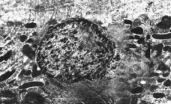(Press-News.org) Have you ever seen a crowd of people looking off into the distance, perhaps toward a passing biker or up to the top of a building? There's a good chance you looked there, too, instantly, even without paying attention to the individuals in the group. How can we tell where a crowd is looking with so little effort?
Researchers at the University of California, Berkeley and the University of Denver have discovered that we rely on a specialized visual process known as "ensemble coding" to perceive where a crowd is looking. Their new study shows that we are able to tell where a group of people is looking, even after just a fraction of a second, by perceiving the group as a single entity rather than a collection of individuals.
This is a photo of a crowd.The findings are published in Psychological Science, a journal of the Association for Psychological Science.
"We see the group as an entity, the same way we see an entire tree without paying attention to the individual leaves," says psychology researcher Timothy Sweeny of the University of Denver. "This highlights the importance of group behavior in human experience – perceiving groups is so important that we have, in fact, evolved dedicated brain processes to perceive them."
Understanding where a group is looking can reveal useful, even vital, information to the viewer; previous research demonstrated that we are actually more responsive to the gaze of a crowd than the gaze of a single person.
"Imagine sitting in the stands at a baseball game. Out of the blue, a dozen people shift their gaze upward, right above your head. Your reaction to this information—is a foul ball headed your way?—will be different than if just one person looked over your head," Sweeny explains.
Sweeny and colleague David Whitney of the University of California, Berkeley wanted to investigate the mechanisms that contribute to this particular form of visual perception. Study participants viewed crowds of computer-generated faces. Sometimes they viewed a full crowd of 4 faces and sometimes they only viewed a subset of 1-3 faces selected from a full crowd. Importantly, the gaze of each of the 16 computer-generated faces was unique.
After viewing a crowd for only one-fifth of a second, participants were asked to estimate where the group was looking, on average, by moving the pupils on a blank face using the right and left arrows on a keyboard. If ensemble coding was at work, Sweeny and Whitney hypothesized, participants' gaze estimates should be better when more information (i.e., more faces) is available.
The data showed that participants' gaze estimates for groups incorporated information from multiple gazes in the crowd, in support of the researchers' hypothesis.
"Even though there wasn't enough time to inspect the individuals, the participants were still able to see the gist of what the entire crowd was doing, as a group," says Sweeny.
According to the researchers, the results indicate that we have a built-in mechanism that allows us to perceive crowd gaze incredibly quickly, and with little effort.
"These findings suggest that many of our complex social behaviors are actually rooted in basic visual processing," says Sweeny.
Sweeny and Whitney believe the findings could elucidate various group-related behaviors, such as panic and rioting, and might, in the future, also shed light on mechanisms that contribute to social deficits in autism spectrum disorders (ASD):
"Exploring how social group perception may or may not be impaired could provide insights into how basic visual deficits might underlie issues of broader social functioning in ASD, which often include disruptions in the perception of global aspects of scenes and perception of eye gaze," Sweeny speculates.
INFORMATION:
This study was supported by National Institutes of Health Grant R01 EY018216 and National Science Foundation Grant NSF 1245461.
For more information about this study, please contact: Timothy Sweeny at timothy.sweeny@du.edu.
The article abstract is available online: http://pss.sagepub.com/content/early/2014/08/11/0956797614544510.abstract
The APS journal Psychological Science is the highest ranked empirical journal in psychology. For a copy of the article "Perceiving Crowd Attention: Ensemble Perception of a Crowd's Gaze" and access to other Psychological Science research findings, please contact Anna Mikulak at 202-293-9300 or amikulak@psychologicalscience.org.
Visual 'gist' helps us figure out where a crowd is looking
2014-08-18
ELSE PRESS RELEASES FROM THIS DATE:
Prioritizing suicide research can help lead to fewer suicide attempts and deaths
2014-08-18
Ann Arbor, MI, August 18, 2014 – In a new supplement to the September issue of the American Journal of Preventive Medicine, experts address the state of the science on suicide prevention and provide useful recommendations for research to inform effective suicide prevention. Suicide has been a challenging and perplexing public health issue to study as it has many dimensions and underlying factors. Although much is known about the patterns and potential risk factors of suicide, the national suicide rate does not appear to have dropped over the last 50 years.
This groundbreaking ...
IU study: Parents' vaccine intentions influenced by how benefits are communicated
2014-08-18
INDIANAPOLIS -- How do parents decide whether to vaccinate their child? In a study designed to formally look at the content of parent-targeted communications about the benefits of vaccination for measles, mumps and rubella, Indiana University School of Medicine investigators report that the framing of these messages influences parents' intentions to immunize their children.
The investigators report that parents who viewed informational material highlighting direct benefits to their own child were the most likely to subsequently indicate that they would have their baby ...
White, straight women leading surge in infertility treatments
2014-08-18
WASHINGTON — Heterosexual white women are twice as likely as racial or sexual minority women to obtain medical help to get pregnant, according to a recent study published by the American Psychological Association.
While income and lack of insurance only partially explained the lower number of racial minority women receiving fertility assistance, lack of insurance appeared to play a crucial role in whether lesbian and bisexual women received medical fertility help, especially in more recent years, according to the nationally representative study published in the APA journal ...
Environment and health experts commit to actions on climate change
2014-08-18
MONTREAL, August 15, 2014 — More than 500 delegates to the EcoHealth 2014 conference have issued a call to action to urgently and collaboratively address the impacts of climate change on the health of humans, animals and the global environment in light of the lack of a truly collective response to date.
Working through the International Association for Ecology and Health (IAEH), the 500 delegates from 62 countries, and the larger ecohealth community they reflect, have developed a vision and commitment to action that will bring together what is already being done to address ...
Stronger drunk driving laws lead to safer roads: Study
2014-08-18
Changes to British Columbia's laws against driving while impaired have reduced fatal crashes as well as ambulance calls and hospital admissions resulting from motor vehicle crashes, a new University of British Columbia study finds.
Researchers concluded that harsher penalties for impaired driving and speeding instituted by the B.C. government in September 2010 reduced crashes related to drinking and driving.
Automobile crashes declined 21 per cent, crash-related hospital admissions dropped 8 per cent and crash-related ambulance calls fell by 7.2 per cent. Based on ...
HSP72 confers protection in retinal ganglion cells and lateral geniculate nucleus neurons
2014-08-18
Optic nerve transection increased the expression of heat shock protein 72 (HSP72) in the lateral geniculate body, indicating that this protein is involved in the prevention of neuronal injury. Zinc sulfate and quercetin induced and inhibited the expression of HSP72, respectively. In a study reported by Dr. Ning Li and co-workers from the First Affiliated Hospital of Anhui Medical University, China, intraperitoneal injections of zinc sulfate, SP600125 (c-Jun N-terminal kinase inhibitor), or quercetin were performed on retinal ganglion cells in a Wistar rat model of chronic ...
Cholecystokinin octapeptide antagonizes apoptosis in retinal pigment epithelial cells
2014-08-18
Oxidative stress may cause retinal pigment epithelial (RPE) cell apoptosis. Nitric oxide and superoxide react to produce peroxynitrite, which, along with its derivatives, are strong oxidants. Cholecystokinin octapeptide-8 (CCK-8) can protect cholinergic neurons against basal forebrain lesion caused by brain injury. Research team at Hebei Province People's Hospital, China led by Dr. Yuan Liu treated human RPE cells with the oxidative stress inducer peroxynitrite, and evaluated the neuroprotective effects of CCK-8. Peroxynitrite triggered apoptosis in these cells, and increased ...
New discovery: Microbes create dripstones
2014-08-18
According to new research humble, microscopic organisms can create dripstones in caves. This illustrates how biological life can influence the formation of Earth's geology - and the same may be happening right now on other planets in space.
According to traditional textbooks dripstones are created by geological or geochemical processes with no influence from living organisms. But now scientists report that formation of dripstones can be a lot more complex than that: Sometimes microbes are responsible for the formation of these geological features.
The researchers from ...
Toothless 'dragon' pterosaurs dominated the Late Cretaceous skies
2014-08-18
A new study provides an exciting insight into the Late Cretaceous and the diversity and distribution of the toothless 'dragon' pterosaurs from the Azhdarchidae family. The research was published in the open access journal ZooKeys.
The Azhdarchidan pterosaurs derive their name from the Persian word for dragon - Aždarha. Interestingly, this derived and rather successful group of pterosaurs included some of the largest known flying animals of all times, with a wingspan reaching between 10 and 12 m.
'Dragon' pterosaurs had a worldwide distribution once and were the last ...
CU Denver study shows zoning regulations impact where marijuana dispensaries can locate
2014-08-18
DENVER (August 18, 2014) – Municipal zoning regulations may push marijuana dispensaries into low income, minority areas, according to a study just released by the University of Colorado Denver.
Published in the Journal of the American Planning Association, the leading professional and academic planning resource, the study shows that government regulations will likely cause an inequitable distribution of marijuana business throughout the city. Though the impact of dispensaries to the neighborhoods in which they are located has yet to be understood, the research is clear ...


